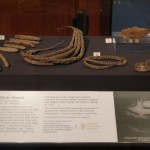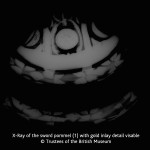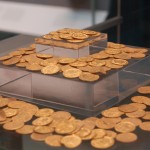Two new hoards of Treasure on show at the British Museum
Yesterday, 3 December 2012, saw the launch of the latest Portable Antiquities Scheme Annual Report (2011) and the Treasure Annual Report (2010) at the British Museum. Among the finds on display for guests to view were a selection of items from a hoard of Viking silver found near Bedale, North Yorkshire, and most of the coins from a hoard of Roman solidi found near St Albans, Hertfordshire. Both of these finds have now been put on temporary display in the British Museum for members of the public to enjoy while they go through the treasure administration procedure.

The hoard of Viking Silver material found in the Bedale Area on display in Room 2 of the British Museum
The hoard of Viking material is now in the Portable Antiquities and Treasure case in Room 2 (‘The Changing Museum’ gallery). On show is a large (546g) necklace composed of four strands of twisted silver wire, now corroded into position in the form of a sizable collar. This was not a discrete item of jewellery! The silver arm ring in the case appears to be well worn compared to similar examples from Silverdale, Lancashire hoard. The iron sword pommel is difficult to view with the naked eye because it is heavily encrusted in soil, but an X-ray by the British Museum’s Department of Conservation and Scientific Research has revealed the presence of elaborate gold-foil decoration. The case is filled out with a selection of some of the silver ingots (elongated masses of metal) found in the hoard.
The finders of the hoard, Stuart Campbell and Steve Creswell, attended the report launch and spoke to guests and the press about the find. When they initially located the hoard in May 2012, they only removed a few of the items before they realised what it was, and, following best-practice, they contacted their local Finds Liaison Officer (FLO) Becky Griffiths rather than attempting to remove any more of the hoard. Becky was able to organise a careful excavation of the hoard, which gave archaeologists the opportunity to record contextual information. As the hoard contains items that are over 300 years old and composed of over 10% precious metal, it was reported to the Coroner for North Yorkshire (Eastern District) as potential Treasure, under the Treasure Act 1996.

X-ray of the sword pommel from the Bedale Hoard
Yorkshire Museum hopes to acquire the find in due course. A report on the contents of the hoard has been prepared for the coroner by the British Museum, and the Coroner will hold an inquest to determine whether the find constitutes Treasure. We hope to have the hoard on display at the British Museum into the New Year.
The hoard of Roman gold solidi (coins) from the late 4th – early 5th century AD was found near St Albans, Hertfordshire, in September 2012. 141 of the 159 coins are currently in the British Museum (the remainder are currently still in the safe keeping of Verulamium Museum in St Albans). The coins have been put in the changing display in the Citi Money Gallery, and are accompanied by a short presentation on the discovery and identification of the coins. The coins from near St Albans represent one of the largest hoards of solidi ever found in Britain – the largest, from the Hoxne hoard, are in the collection of the British Museum.
As the hoard represents a find of two or more coins at least 300 years old containing more than 10% precious metal, it was also reported to the

Roman solidi from the hoard found near St Albans, Hertforshire, on display in the Citi Money Gallery at the British Museum
Coroner for Hertfordshire as potential Treasure. Verulamium Museum hopes to acquire the hoard, and a comprehensive report on the coins is being prepared for the Coroner, who will hold an inquest in due course to make a ruling as to whether or not the hoard fulfils the criteria for Treasure. It is anticipated that the coins will be on show at the British Museum for about a month’s time.
If the Coroners for North Yorkshire and Hertfordshire declare the respective hoards to be Treasure, they will vest in the Crown, which will seek to place them in the local museums mentioned above. The hoards will be valued by the independent Treasure Valuation Committee and the finders and owners of the land where the hoards were found will be eligible to receive a reward equal to the market value of the hoards.